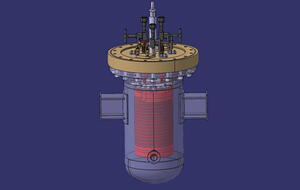One last procurement for Korea
In December 2023, ITER celebrated the completion of the main construction work on the Tritium Building—a "formidable adventure" initiated 14 years earlier under Europe's responsibility. Once fully equipped, the facility will handle the rare, expensive and slightly radioactive element tritium which, along with the other hydrogen isotope deuterium, composes the gaseous mix forming the fusion plasma. On Wednesday 26 March, a Procurement Agreement was signed with the Korean Domestic Agency to deliver what can be considered the very heart of the tritium plant: the storage and delivery system (SDS) that will occupy an entire level of the Tritium Building.
For the Korean Domestic Agency and its director Kijung Jung, the signature was highly symbolic: the Procurement Agreement represents the ninth and last “package” to be signed by Korea in the context of the original division of tasks among the Members. For the ITER Organization, it marked a decisive step in the completion of a facility that needs to be ready for commissioning by 2030. “The storage and delivery system is at the crossroads of the tritium plant,” explains Ian Bonnett, who leads the Tritium Plant Project. “It will act as a fuel distribution centre not only for tritium but for non-radioactive gases such as deuterium, nitrogen, neon or argon required by different systems within the installation. When ITER is ready for deuterium-tritium operation, it will receive the tritium from suppliers and ensure that it is properly stored and available when required.”
Tritium, an isotope of hydrogen, will be stored in “hydride beds” that passively lock hydrogen in a solid matrix at room temperature. The storage and delivery system will accommodate 52 such beds, with the possibility of extension to meet ITER needs. As a side benefit helium-3, the highly valuable decay product of tritium, will be harvested from the hydride beds and collected for use in ITER or in other scientific experiments.
ITER will be by and far the largest tritium consumer ever. It is expected that the project’s scientific program will use the better part of the tritium inventory worldwide, estimated at a few dozen kilograms¹. Once industrialized, fusion will rely on tritium breeding, whose tools and techniques will be developed and tested in ITER’s Test Blanket Module program.
¹The only source of readily available tritium is a type of fission reactor called CANDU where tritium is created by neutron capture in the heavy water coolant. CANDU reactors were initially developed by Canada and are presently operated in Canada, China, Korea, Romania and Argentina.



